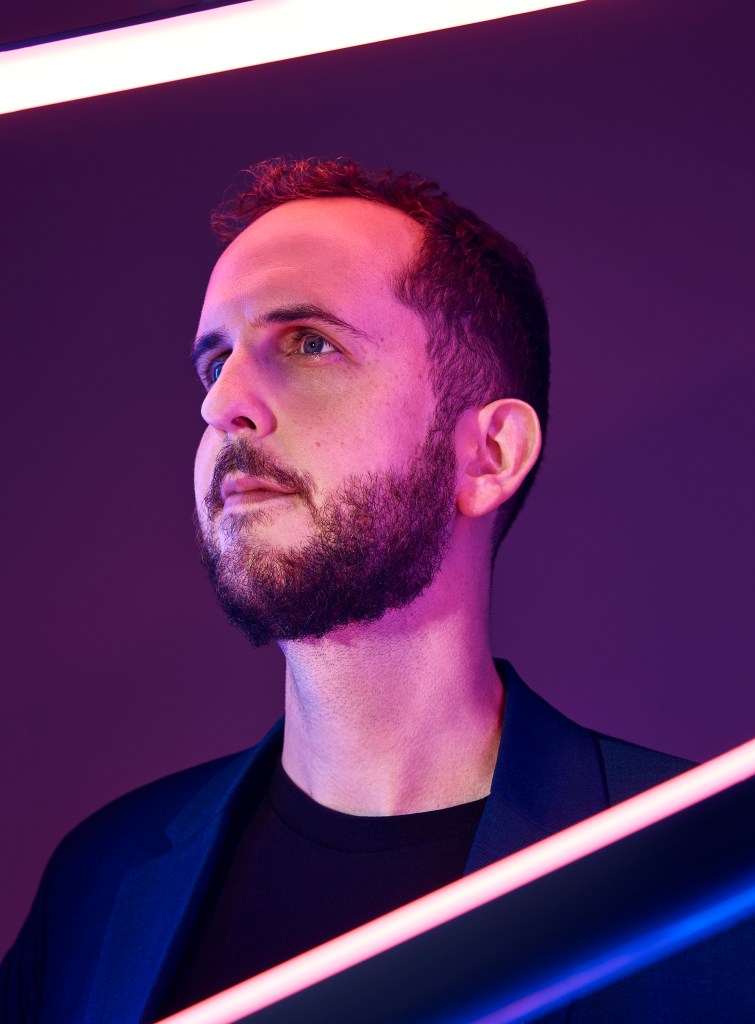Meet Robbie and James Ferguson, two of Australia’s rangers of the wild, wild, Web 3.0, and some experts who are contemplating whether it’ll be a game-changer – or not.
Billion dollar brothers Robbie and James Ferguson will share their full story live at the Forbes Australia Business Summit. You can secure your ticket here.
Key Takeaways
- Immutable closed a US$200 million Series C capital raise in March, valuing the business at US$2.5 billion
- The Ferguson brothers predict Web 3.0 will first take over games and digital entertainment, then finance, then real-world property
- Immutable’s valuation has stayed solid in the recent tech market chaos, with the company raising a further $21.5 million in July

“Web 3.0 is going to eat the world,” says 30-year-old James Ferguson, as he sits in front of an A2-sized framed picture of a charging bull, with a giant golden Bitcoin on its back.
Called Bull Run, that piece of artwork was created by non-fungible token (NFT) artist Mike Winkelmann, who goes by the alias Beeple. James says he was given the hardcopy (not the NFT) by his younger brother, 25-year-old Robbie.
James’ credentials for making this game-changing prediction about Web 3.0’s appetite are arguably strong.
“I think all the value in the world – or most value in the world – [will end] up being under the hood, backed by blockchain technology.”
– Robbie Ferguson, president of Immutable
He and Robbie co-founded Immutable, Australia’s fastest growing unicorn [a private company that achieves a valuation of $1 billion] – and possibly the country’s most successful Web 3.0 company. James is chief executive, and Robbie is president and both are alumni of the 2019 Forbes 30 Under 30 Asia list.
It started in 2018 as Fuel Games, the developer and publisher of NFT-based games Gods Unchained and Guild of Guardians. It rebranded as Immutable in 2019, and later added an NFT exchange platform. It was last valued at US$2.5 billion.
The Fergusons predict Web 3.0 will first take over games and digital entertainment, then finance, then real-world property.
“I think all the value in the world – or most value in the world – [will end] up being under the hood, backed by blockchain technology. What’s beautiful about it is it’s a fundamentally open piece of infrastructure, which has better transparency and empowers everyday people more,” Robbie says.
Others, like software engineer and Wikipedia editor Molly White, think Web 3.0 is total nonsense, that it does not exist at all, but is simply a (very effective) marketing ploy to get you to buy more cryptocurrency – and then possibly lose it.

To anyone who says don’t do business with family, James gives you his permission – so long as your family is extraordinarily smart (and it helps if they’re a software engineer). James is referring to the fact that Robbie was a star student. He finished top of his school and began a computer science and law double degree that he hasn’t finished, but it was how he met Immutable’s third co-founder and current chief technology officer, Alex Connolly.
James jokingly calls himself a recovering law student. He’d always had an interest in building tech companies, so he took a year off his commerce and law double degree to pursue coding in San Francisco.
It wasn’t necessarily their drive for pioneering Web 3.0 success that gave birth to Immutable – the founders just loved video games.
“We used to play countless hours of RuneScape and League of Legends – it actually really used to annoy our parents,” James says. “Luckily, it was essentially opening us up to how much of this world was going to be digital.”
In 2015, the brothers saw the promise of Ethereum, a popular blockchain-based platform for developers that supports smart contracts, where the terms of transactions are coded and immutable – hence the name of the Fergusons’ business.
Then came NFTs. These are digital collectibles that can’t be replaced by anything else. The transaction record of who’s bought and sold each individual NFT exists on the Ethereum blockchain.
When one of the first NFT collections, CryptoPunks, launched in 2017, the Ferguson brothers had an epiphany.
“CryptoPunks was what I would call a proof of concept for a crypto collectible. We thought it was very cool, but for us, the idea of taking that and combining it with video games was so obviously a better system,” James says.
They worked for months and months and created the world’s first multiplayer competitive blockchain game: Etherbots.
“Luckily, the world thought it was pretty cool,” James says. A humble response, considering that game brought in $1 million in revenue in its first week.
Etherbots gave the Fergusons the confidence – and the legitimacy – to raise capital. Shortly after came their next iteration of blockchain gaming – Gods Unchained, Guild of Guardians – and then Immutable X, a Layer 2 solution on top of the Ethereum blockchain.
Layer 2 solutions are used to solve a lot of the scalability, cost and user experience issues of the Ethereum blockchain. In Immutable’s case, they use a zero-knowledge (ZK) rollup, which allows multiple transactions to be bundled into one, reducing time and fees.
The platform allows individuals and businesses to build their own NFT projects, like play-to-earn games, in hours rather than weeks, while maintaining the same level of security provided by the Ethereum blockchain. Companies including TikTok, Disney and GameStop chose Immutable X to power their entry into digital collectibles (helped by the brothers’ claim it is carbon neutral).

Ethereum was working to iron out those usability kinks itself, merging from a proof-of-work chain to a proof-of-stake chain in September. This means the network now requires 99.9% less energy to verify transactions.
But that doesn’t make Layer 2 solutions redundant, Robbie says. “The merge is primarily aimed at reducing Ethereum’s energy consumption … but it will do nothing to address Ethereum’s scalability issues.”
Though Robbie says the merge is a critical part of Ethereum improving, you’ll still only be able to trade roughly five NFTs per second.
“When combined with Immutable X, we are able to achieve more than 10,000 transactions per second.”
The Fergusons, fuelled by their early successes, are almost fanatical about Web 3.0. There’s evidence to suggest they have reason to be, with a Brandessence Market Research study predicting the global Web 3.0 blockchain market will reach US$42 billion by 2028.
The brothers start to get visibly excited when they talk about the point of convergence between NFTs and decentralised finance (DeFi), which they say will lead to better outcomes for consumers. Think: digital property titles or tokenised term deposits.
DeFi is a new wave of blockchain-based financial technology that removes the intermediaries in financial transactions, theoretically allowing people to transact in seconds. It is still relatively new, and the regulators certainly have not caught up, but the Fergusons expect NFTs to be crucial in DeFi’s evolution.
They believe NFTs can speed transactions by acting as a digital proof of ownership when people are making finance applications. They can also solve illiquidity problems: it’s tricky to sell a real piece of artwork, but it’s easier to trade a digital one.
This transition will take a while, about a decade, maybe longer, James forecasts. “If instead your land title is put inside NFTs, not only are they easily tradeable, they can interact with other smart contracts that have been built for NFTs. Some of those smart contracts allow for collateralised lending,” James says. “This is where you start seeing a lot of the possibilities for what’s on the open system of finance.”

Meanwhile, White keeps a live blog, Web3isgoinggreat.com, which she says shows just how much of a grift Web 3.0 really is. To her, this all sounds ridiculous.
“How is this better than the existing system?” she questions. White does not profit from the website, nor does she own any cryptocurrencies or NFTs. She logs layoffs in Web 3.0 companies, hacks, scams, phishing attacks and the amount of money lost to intentional Web 3.0 grifts via a grift counter.
“Realistically, you can’t just replace a piece of paper with an NFT. If you start to play it out, you still have laws and trusted authorities, like the government or the town clerk’s office, who oversee those types of transactions.”
So, we end up with the exact same system we have right now, she says, middlemen and all. She also has bones to pick with those who think Web 3.0 will be a decentralised utopia. “We can dream, but the whole idea of owning your own data is a red herring,” she says.
“No one has forced you to give your data to Facebook today. You chose to do so for various reasons, and that will not go away with Web 3.0. You will still have to make those choices about who you share your data with.”
At the time of writing, White’s grift counter had tracked US$10.5 billion of money lost to Web 3.0 scams, which has made her ruthless about the venture capital funds (and the people behind them) supporting Web 3.0 projects.
“They’re very mercenary,” she says. “The arrival of crypto has been a windfall for VCs. It’s been like a dream. Now, they can cash out on their investments enormously, and more quickly than they could with traditional investments.”
But the Immutable brothers are not fazed by the naysayers.
Immutable closed a US$200 million Series C capital raise in March, valuing the business at US$2.5 billion, which made it one of Australia’s fastest growing unicorns. It also took the brothers’ combined net worth to a reported $1.01 billion.
Big backers of Immutable’s Series C round included Temasek and Tencent, the former being the Singaporean sovereign wealth fund, the latter the world’s largest video game vendor. It was Tencent’s first Web 3.0 public investment.
Immutable’s valuation has stayed solid in the recent tech market chaos, with the company raising a further $21.5 million in July at the same valuation as when it closed its Series C round.
Immutable early investor AirTree Ventures says blockchain technology is part of the future, unlocking innovation like digital property rights and a more open financial system.
John Henderson, lead investor for AirTree’s new $50 million Web 3.0 fund, says Robbie and James have what it takes to make it happen. “They have a shared vision and a natural knack for leadership that I have only witnessed among a handful of founders – all of whom are at the helm of unicorn startups,” Henderson says.
Henderson adds that Immutable will be the backbone of a future in which NFTs permeate many sectors, starting with gaming.
“The vast majority of the world’s value is unique.”
– Robbie Ferguson, co-founder of Immutable
As for now, the Immutable brothers say they are working intently on making Web 3.0 as dependable as possible: starting with increasing the uptime of the blockchain. Uptime is when the blockchain is working, downtime is when it’s not.
Robbie claims Immutable has “two to three orders of magnitude superior uptime” than the next-best blockchain or Layer 2 solution. That means Immutable’s uptime is higher than the rest.
If Immutable X does solve some of the blockchain’s reliability issues, it is well placed to be the platform for a serious chunk of the market for Web 3.0 games and beyond, but competition in this space can evolve quickly.
Regardless, Immutable believes Web 3.0 is coming, and it will change everything.
“The vast majority of the world’s value is unique and for the first time, we can have a token which allows people to trade this value for the fairest possible price, with true digital property rights,” he says.
“That’s why it’s turning into this unstoppable force. People believe in a fairer future.”
What is Web 3.0?
Web 1.0 was the first phase of the internet, a time of static pages, where browsers had no interactive features.
Web 2.0 began with the influx of social media sites, including MySpace and Facebook. The transition was marked by the ability for users to contribute content to the web. Arguably, Web 2.0’s largest legacy is the destruction of data privacy. In 2016, the data of millions of Facebook users was harvested by British consulting firm Cambridge Analytica without consent and used for political advertising.
Web 3.0 is still evolving, but it is the notion that the internet becomes decentralised, and users take more ownership of their data. That means the internet would be based on public blockchains. Sites would no longer be accessed through platforms like Google or Facebook, but rather through individual blockchain-backed networks.
Where are they on the map?
Co-founder of Immutable-backer King River Capital Chris Barter believes Immutable is at the forefront of efficiently, and cheaply minting and trading NFTs.
However, he acknowledges it isn’t the only player in the game. You would be hard-pressed to find a successful Web 3.0 company in Australia that doesn’t have a US counterpart, and vice versa, Barter says.
Arbitrum, which is headquartered in the US, is a Layer 2 solution, like Immutable X, that’s designed to improve Ethereum’s capabilities.
US-founded Polygon, formerly known as the Matic Network, is also a scalable solution to the Ethereum blockchain. Instead of using a Layer 2 solution, it uses side-chains of the blockchain to provide faster and cheaper transactions on Ethereum.
Then there’s Magic Eden, the leading NFT marketplace based on San Francisco’s Solana, a different blockchain that works faster than Ethereum, and is cheaper to use.
Immutable also faces competition in the gaming space from Forte and Enjin Coin, which offer tools for companies to create their own NFTs.
Immutable’s main advantage is that it occupies a position in almost every segment of the blockchain-based gaming industry.
